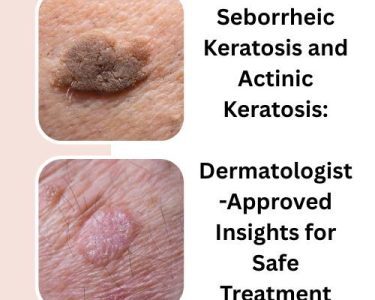Seborrheic keratosis is one of the most common benign skin growths that often appear on the face, neck, chest, and other parts of the body. While it is harmless, many people seek treatment because of cosmetic concerns, especially when these growths appear on the face. Fortunately, there are several safe, natural, and effective remedies for seborrheic keratosis and one of the most talked-about is castor oil for seborrheic keratosis.
You need to know about seborrheic keratosis face treatment, including its causes, symptoms, medical options, and natural treatments for seborrheic keratosis, with a special focus on castor oil seborrheic keratosis remedies.
What Is Seborrheic Keratosis?
Seborrheic keratosis is a non-cancerous skin growth that develops from the outer layer of skin cells called keratinocytes. These growths can appear as light tan, brown, or even black lesions, often with a waxy, rough, or scaly surface. They may look alarming, but they are entirely benign and not contagious.
They typically appear in middle-aged and older adults, although younger individuals can also develop them. Genetics play a significant role if your parents had seborrheic keratoses, you are more likely to develop them as well.
Common Causes and Risk Factors
Although the exact cause of seborrheic keratosis remains unclear, several factors can contribute to its development:
- Genetics: A strong family history is the most common cause.
- Aging: The condition is most common in individuals over 40.
- Sun Exposure: Prolonged UV exposure may accelerate the appearance of these growths.
- Hormonal Changes: Pregnancy or hormonal fluctuations can sometimes trigger their growth.
- Friction: Constant rubbing or irritation on the skin can encourage lesion formation.
Related Article: Can You Really Treat Seborrheic Keratosis with Supplements? Read This First!
Symptoms and Appearance
Seborrheic keratoses can vary in appearance but often share these characteristics:
- Flat or slightly raised lesions
- Waxy, wart-like, or rough texture
- Tan to dark brown color
- “Stuck-on” appearance, as if glued to the skin
- Itching or irritation (in some cases)
While they are benign, any sudden changes in color, shape, or bleeding should be examined by a dermatologist to rule out skin cancer.
Why Facial Seborrheic Keratosis Requires Gentle Treatment
The face is a sensitive and highly visible area, making treatment for seborrheic keratosis more delicate. Harsh chemical treatments or surgical removal methods can sometimes leave scars or pigmentation issues. This is why many people look for natural treatments for seborrheic keratosis that are gentle yet effective — especially castor oil for seborrheic keratosis.
Conventional Treatments for Seborrheic Keratosis on the Face
Dermatologists often recommend several medical options depending on the size, location, and number of lesions. Common procedures include:
Cryotherapy (Freezing)
Liquid nitrogen is used to freeze and destroy the growth. This is quick but may cause mild scarring or pigmentation, especially on the face.
Curettage
The growth is scraped off under local anesthesia using a special surgical tool. It’s effective but may leave marks.
Laser Therapy
Laser removal is precise and effective for facial lesions, with minimal scarring. However, it can be expensive.
Electrocautery
This involves burning the growth with electric current. It’s effective but not suitable for everyone, especially those with darker skin tones due to risk of pigmentation.
Topical Treatments
Certain prescription creams may help reduce the appearance of seborrheic keratosis, though results vary.
While these methods are medically proven, they may not appeal to everyone due to cost, discomfort, or the potential for scarring. This is where natural treatments for seborrheic keratosis come into play.
Related Article: Natural Remedies for Seborrheic Keratosis at Home
Natural Treatment for Seborrheic Keratosis
Natural remedies are becoming increasingly popular because they are gentle on the skin, cost-effective, and have minimal side effects. These remedies focus on hydrating the skin, promoting regeneration, and reducing irritation or inflammation. Among them, castor oil for seborrheic keratosis is one of the most recommended options.
Let’s explore the most effective natural treatments for seborrheic keratosis on the face.
Castor Oil for Seborrheic Keratosis
Why Castor Oil Works
Castor oil, extracted from the seeds of the Ricinus communis plant, is rich in ricinoleic acid — a powerful anti-inflammatory and skin-healing compound. It is known for its moisturizing, antibacterial, and regenerative properties, which make it ideal for treating various skin conditions, including seborrheic keratosis.
Here’s how castor oil seborrheic keratosis treatment works:
- Softens the Lesion: Castor oil penetrates deep into the skin, softening the keratin buildup that forms the lesion.
- Reduces Inflammation: Its anti-inflammatory compounds soothe irritation and redness.
- Promotes Healing: Regular use can help the skin regenerate and restore its natural tone.
- Gentle on the Face: Castor oil is mild and suitable for delicate facial skin.
How to Use Castor Oil for Seborrheic Keratosis
Method 1: Castor Oil Alone
- Clean the affected area with warm water and mild soap.
- Pat dry gently with a soft towel.
- Apply a small amount of pure, cold-pressed castor oil directly to the lesion.
- Massage gently for 2–3 minutes.
- Leave it overnight and rinse in the morning.
- Repeat daily for several weeks.
Method 2: Castor Oil and Baking Soda
This combination acts as a gentle exfoliant that can speed up healing.
- Mix 1 teaspoon of baking soda with 2 teaspoons of castor oil.
- Apply the paste to the seborrheic keratosis.
- Leave it on for 30–60 minutes, then rinse with warm water.
- Use 3–4 times a week.
Method 3: Castor Oil and Tea Tree Oil
Tea tree oil adds antimicrobial benefits.
- Mix 1 tablespoon of castor oil with 2 drops of tea tree oil.
- Apply to the lesion twice a day.
- Continue until visible improvement appears.
Important Tip: Always perform a patch test before using any natural remedy to avoid irritation or allergic reactions.
Related Article: 10 Natural Remedies for Seborrheic Keratosis
Apple Cider Vinegar
Apple cider vinegar (ACV) is a popular home remedy due to its acidic properties that can help exfoliate dead skin cells and reduce keratin buildup.
How to Use:
- Mix equal parts of ACV and water.
- Dip a cotton ball and apply to the affected area.
- Leave for 10–15 minutes and rinse with water.
- Apply moisturizer afterward to prevent dryness.
When used consistently, ACV can help lighten seborrheic keratosis lesions. However, it should be used cautiously on facial skin to avoid burns or irritation.
Aloe Vera Gel
Aloe vera is known for its soothing and healing abilities. Its natural enzymes can help reduce inflammation and promote cell regeneration.
How to Use:
- Extract fresh aloe vera gel from a leaf.
- Apply directly to the lesion and leave it on for 30 minutes.
- Rinse with warm water.
- Repeat twice daily.
Aloe vera is particularly beneficial for sensitive or irritated skin affected by seborrheic keratosis.
Related Article: Treatment of Seborrheic Keratosis Symptoms
Coconut Oil
Coconut oil is rich in fatty acids that nourish and soften the skin. Regular application can help reduce irritation and dryness around seborrheic keratosis lesions.
How to Use:
- Apply a few drops of virgin coconut oil to the affected area.
- Massage gently until absorbed.
- Use daily for best results.
Green Tea Extract
Green tea contains antioxidants and anti-inflammatory compounds that promote skin healing and may slow the growth of keratinocytes.
How to Use:
- Brew green tea and allow it to cool.
- Apply the tea to the lesion using a cotton ball.
- Leave it on for 20 minutes before rinsing.
Combining Natural Remedies with a Healthy Lifestyle
To enhance the effectiveness of natural treatment for seborrheic keratosis, consider adopting the following skincare and lifestyle habits:
- Sun Protection: Use a broad-spectrum sunscreen daily to prevent lesions from darkening or spreading.
- Gentle Cleansing: Use mild, non-comedogenic cleansers to avoid irritation.
- Hydration: Drink plenty of water and use natural moisturizers like castor oil or aloe vera.
- Healthy Diet: Consume foods rich in antioxidants, vitamins A, C, and E to promote skin health.
- Avoid Scratching: Never try to pick or scratch off the growths; it can cause infection or scarring.
Scientific Support for Castor Oil Seborrheic Keratosis Treatment
Although scientific research on castor oil for seborrheic keratosis is limited, studies support castor oil’s general benefits for skin health. Ricinoleic acid, the main active compound, has been shown to:
- Support wound healing
- Reduce inflammation
- Hydrate dry skin
- Provide antimicrobial protection
These properties align with the needs of seborrheic keratosis management — particularly softening hardened keratin layers and soothing irritated skin.
Many anecdotal reports and user experiences suggest that regular application of castor oil seborrheic keratosis treatments can reduce lesion size and improve skin appearance over time.
Related Article: Seborrheic Keratosis Melanoma Skin Cancer
Precautions and When to See a Doctor
While natural remedies like castor oil for seborrheic keratosis are generally safe, it’s important to take precautions:
- Consult a dermatologist before starting treatment, especially if the lesion changes shape, color, or bleeds.
- Avoid harsh scrubbing or using concentrated acids on facial skin.
- Stop use immediately if you experience redness, itching, or burning.
Remember that natural remedies may take time patience and consistency are key.
The Benefits of Natural Treatment for Seborrheic Keratosis
Choosing a natural remedy over surgical or chemical options has many advantages:
- Gentle on Skin: Perfect for facial areas prone to irritation.
- No Scarring: Non-invasive and reduces risk of pigmentation.
- Affordable and Accessible: Easily available ingredients like castor oil and aloe vera.
- Long-Term Skin Health: Promotes hydration and healing.
Final Thoughts
Seborrheic keratosis on the face can be distressing, especially when it affects your appearance. However, you don’t always need to resort to invasive procedures. With patience and consistent care, natural treatments for seborrheic keratosis especially castor oil for seborrheic keratosis can significantly improve skin texture and appearance.
Castor oil seborrheic keratosis treatments offer a gentle, safe, and effective alternative that nourishes your skin while gradually reducing the growth. Combined with good skincare practices and healthy living, this natural approach helps you achieve clearer, smoother, and more radiant skin without the risks of scarring or harsh chemicals.




